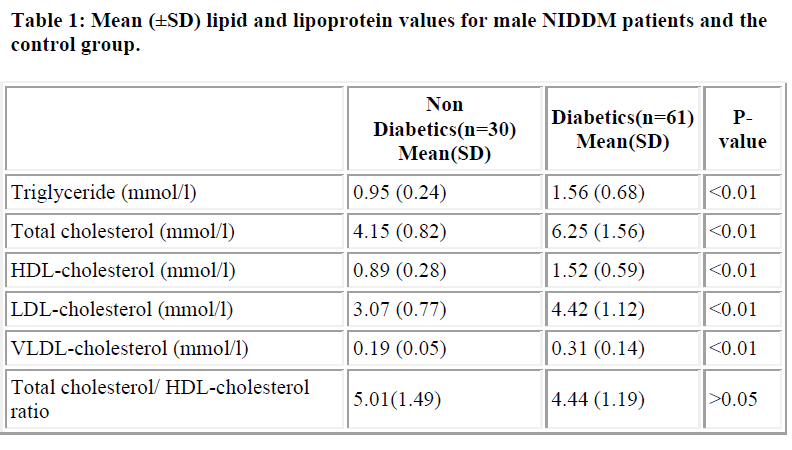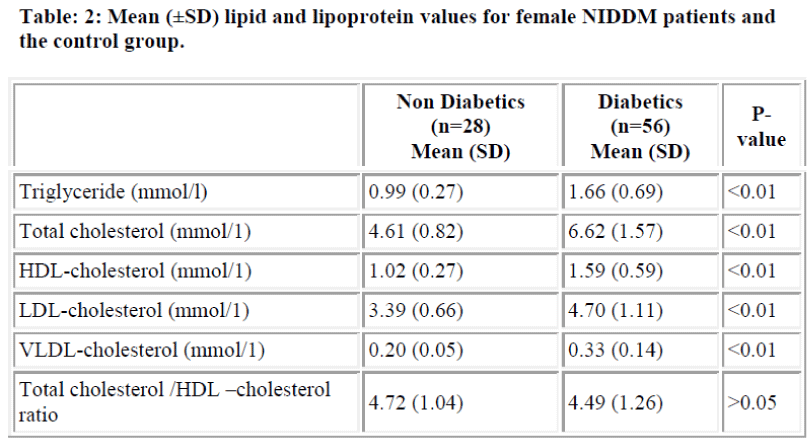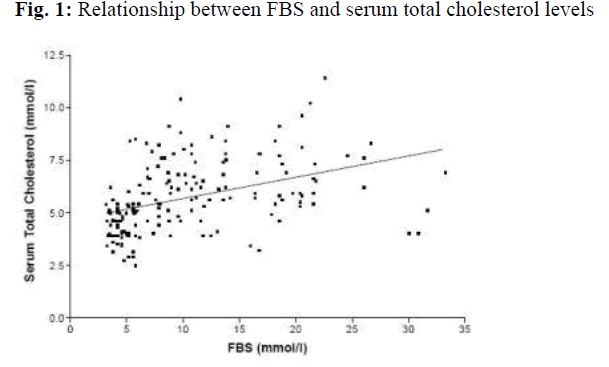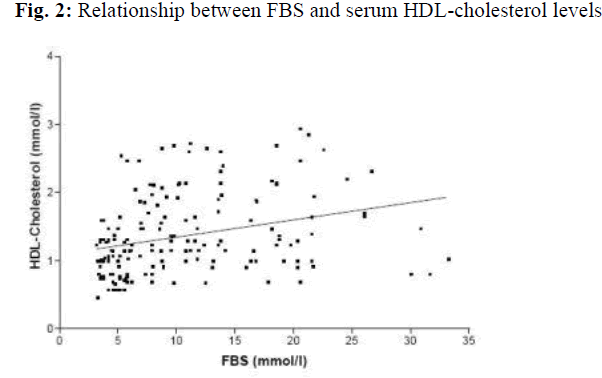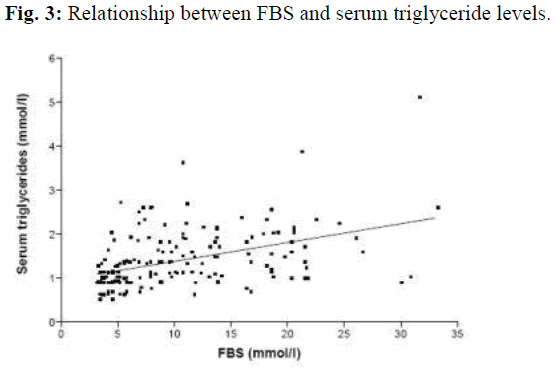- Biomedical Research (2007) Volume 18, Issue 1
Lipid and lipoprotein profiles in Nigerian non-insulin-dependent diabetic patients
Ignatius C. Maduka1, Joel O. Onyeanusi2, Elvis N. Shu3 and Chidi Duru11Department of Chemical Pathology, University of Nigeria Teaching Hospital (U.N.T.H.), P.M.B. 01129, Enugu, Nigeria
2Department of Medical Laboratory Sciences, University of Nigeria, Enugu Campus, Nigeria
3Department of Pharmacology, University of Nigeria, Enugu Campus, Enugu, Nigeria
- *Corresponding Author:
- Ignatius C. Maduka
Department of Chemical Pathology U.N.T.H
PMB 01129, Enugu, Nigeria
Tel: +234 42 305237
E-mail: madukaig@yahoo.com
Accepted date: October 27, 2006
Abstract
The lipid and lipoprotein profiles of 117 non-insulin-dependent diabetes mellitus (NIDDM) patients were determined in order to identify and characterize the lipid and lipoprotein abnormalities associated with Nigerian NIDDM patients. 58, age matched apparently healthy individuals served as a control group. The electrophoretic migration pattern of serum lipoproteins on cellulose acetate paper was also studied. Statistically significant increases (p<0.01) were observed in the mean values of Triglycerides, Total cholesterol, HDL-cholesterol and VLDL-cholesterol for both male and female diabetics when compared to their corresponding controls. However, there were no significant differences (p> 0.05) between the mean values of the male diabetics and nondiabetics when compared with their female counterparts. Also, there were statistically significant positive correlations between fasting blood sugar (FBS) and serum Total cholesterol levels (r = 0.4075, p < 0.0001); and FBS and HDL-cholesterol levels (r = 0.2948, p < 0.0001). No distinguishable differences in mobility and number of bands were observed in the lipoprotein electrophoresis pattern of both the diabetics and control subjects. However, electrophoresis showed increased lipoprotein fractions in the diabetics. Significant positive correlation between fasting blood sugar and lipid fractions suggest that the duration and severity of diabetes mellitus may increase the risk of atheroma.
Keywords
Lipid, Lipoprotein, Nigeria, Diabetics.
Introduction
Diabetes mellitus is a metabolic disease with abnormalities affecting all major metabolic pathways. Non-insulin-dependent diabetes mellitus as well as other non communicable diseases such as ischaemic heart disease, hypertension, and cancers are public health problems in both developed and developing countries [1]. High blood cholesterol is one of the main modifiable factors for coronary artery disease and has been rated as the greatest risk factor for cardiovascular disease [2].
Atherosclerosis has been reported as the most important cause of morbidity and mortality in long standing diabetes mellitus. The association between hypercholesterolaemia and atherosclerotic heart disease is an established fact [3]. Atherosclerosis and thrombosis produce occlusive vascular lesions in humans, which may lead to such adverse clinical conditions as stroke, myocardial infarction or peripheral vascular disease [4].
Lipid and lipoprotein levels vary widely depending on ethnic groups, genetic and environmental factors as well as severity and duration of the diabetic state in the non-insulin-dependent (NIDDM) patients [5-7]. Disturbances in lipoprotein transport and overt hyperlipidaemia are frequently encountered in NIDDM and in persons at high risk of developing diabetes, such as those with impaired glucose tolerance [8]. It is imperative that lipid abnormalities in diabetic patients be identified and treated immediately.
Although there has been a report of high serum Total and HDLcholesterol in Nigerian diabetics [9], this report is silent on Triglyceride and other lipoprotein fractions. Since there are dietary and ethnicity-based variations in lipid and lipoprotein levels and the risk of coronary artery disease [5-7], it is necessary to study these parameters in the Nigerian diabetic patients in order to establish optimal treatment for dyslipidaemia in NIDDM, especially with the report of high diabetic inpatient mortality in Nigeria [10]. This study, therefore seeks to identify and characterize the lipid and lipoprotein abnormalities associated with Nigerian diabetic (NIDDM) patients as compared to the normal nondiabetics. This will assist in achieving adequate dietary and therapeutic control of NIDDM and subsequent hyperlipidaemia in Nigerian population.
Materials and Methods
Subject and Sample Collection
A total of 61 male and 56 female non-insulin-dependant diabetic patients attending the Diabetic Clinic of the University of Nigeria Teaching Hospital (UNTH), Enugu, Nigeria were involved in the study. Patients on insulin therapy were excluded. 30 male and 28 female, age matched apparently healthy subjects served as control groups. Informed consent was taken from all the subjects.
Five ml of venous blood was drawn from the antecubital vein of each subject after an overnight fast. 2ml of the blood was transferred into Fluoride-oxalate tube for FBS, and 3ml to plain venoject tube for lipid studies respecttively. The sera were separated by centrifugation at 3000 rpm for 5minutes and stored at 40C. All analyses were carried out within 48hours of blood collection. Samples and reagents were brought to room temperature before analysis. Electrophoresis was carried out on randomly pooled diabetic sera and control sera within 24 hours of blood collection. Commercial control serum (QCA SERISCANN, Quimica Clinica Applicada, S. A, Spain) was included in each assay batch to evaluate the assay method and reproducibility.
Analytical Methods
Serum Triglycerides and Total cholesterol were quantified using enzymatic methods [11,12]. HDL-Cholesterol was estimated in the supernatant after precipitation of serum with magnesium chloride-phosphotungstic reagent [13]. Low density lipoprotein (LDL) cholesterol and very low density lipoprotein (VLDL) cholesterol were estimated using National Cholesterol Education Programme (NCEP) and Friedwald’s formular [14,15], while serum lipoprotein electrophoresis was determined using cellulose acetate electrophoretic method [16].
Statistical Analysis
Data were analyzed separately using paired t - test. Correlation analyses were done by the use of computer software program, Graph Pad Prism. Results were expressed as means + SD (standard deviation).
Results
The mean (+SD) values of lipid and lipoprotein levels for male and female NIDDM patients and for the control groups are shown in Tables 1 and 2 respectively. There was a similar pattern in the mean values for the male and female diabetic and non-diabetic groups. There were statistically significant increases (P<0.01) in the mean values of Triglycerides, Total cholesterol, HDL-cholesterol, LDL-cholesterol and VLDL-cholesterol for both male and female diabetics when compared with the controls. When the males and females are compared a significant difference in means (P < 0.05) of total cholesterol was seen in the control group, but not in the NIDDM group. The other fractions show a nonsignificant difference in means (P>0.05) for both groups.
The relationship between FBS and lipid fractions are shown in figures 1-3. There were statistically significant positive correlations between FBS and serum Total cholesterol (r= 0.4075, p<0.0001), FBS and HDL-cholesterol (r= 0.2948, p<0.0001), and FBS and Triglyceride levels (r= 0.4447, p<0.0001).
Discussion
Lipid and lipoprotein abnormalities are common in the diabetic population due to the effects of insulin deficiency and insulin resistance on key metabolic enzymes [18]. Glucose tolerance, insulin resistance and plasma insulin levels have been implicated in abnormal plasma lipoprotein levels [19,20] and hyper insulinaemia has been linked with the development of atherosclerotic vascular complications especially in the diabetic male patients [21-23]. Cholesterol metabolism, especially in association with specific plasma lipoproteins, influence the development of atherosclerosis in humans [24]. An increased cardio vascular risk in diabetic patients attributed to qualitative and quantitative changes in lipoprotein transport and overt hyperlipidaemia are frequently encountered in NIDDM [25].
In the present study, there were elevated levels of serum Triglycerides, Total cholesterol, HDL, LDL and VLDLcholesterol when compared with the non-diabetic group. When stratified according to sex, there was a similar pattern for both males and females. There was a significant increase (P<0.01) in the mean values of Triglycerides, Total cholesterol, HDL-cholesterol, LDL-cholesterol and VLDL-cholesterol in both male and female Nigerian NIDDM patients.
Cholesterol concentrations have been classified on the basis of relative risk to health irrespective of age or sex [26]. Levels above 5.20mmol/L and 3.36mmol/L for Total cholesterol and LDLcholesterol respectively, have been classified to be risky to health while values above 6.20 and 4.14mmol/L are of very high risk. The mean values obtained in this study (Tables 1 and 2) show that both male and female Nigerian NIDDM patients are at risk for atheroma diseases unlike the control subjects. This indicates a possible outbreak of atherosclerosis amongst the Nigerian NIDDM patients and suggests that their lipid profile should be critically monitored, and adequate dietary and therapeutic control measures be instituted. Similar reports recorded in this study were made by El-Hazmy and Warsy [27] and Laakso, et al [28] in Saudi Arabia and Finland respectively. Their reports however differ from the present findings in that the HDL-cholesterol level in the Finnish diabetics [28] were markedly reduced when compared with the results of the present study. Furthermore, Onyemelukwe and Stafford [29] reported a low level blood HDL-cholesterol but stated that this is not in itself an indicator of atheroma since the distribution of cholesterol between the lipoprotein classes is not disturbed if the Total cholesterol is also low. Increased fasting Triglyceride levels seen in this study confirms the fact that relative hypertriglyceridaemia (but not cholesterol) is often seen in Type 2 diabetic patients [30].
There was a significant positive linear correlation between FBS and Serum Total-cholesterol, HDL-cholesterol and Triglycerides (figures 1-3). This is in agreement with the reports of El- Hazmy and Warsy [27], and Hague [31] that longstanding hyperglycaemia rather than blood glucose level is broadly related to the diabetic complications seen in the diabetics. It was not possible to confirm this since hyperglycaemic duration was not established in this study, as most of the patients have been diabetic for a long time without knowing. They only sought medical attention when their conditions worsened. However the positive linear relationship obtained seems to suggest that the duration and severity of diabetes mellitus may increase the risk of atheroma disease.
There was no distinguishable difference in the lipoprotein electrophoresis pattern (Fig. 4) of the diabetics (a and d) when compared to the nondiabetics (b and c) in terms of number of bands and mobility. However, a and d both show more intensely stained and broader fractions confirming higher concentration of the lipid fractions in the diabetics. Although high levels of serum cholesterol and Triglycerides are well recognised risk factors for Ischaemic heart disease, a lower incidence has been observed in Africans than in the Caucasians (including in the diabetics) [5]. The present study shows that although serum Total cholesterol and Triglycerides are increased in the Nigerian NIDDM patients when compared with the control group, the values are still lower than that obtained in caucasians.
However, the levels are higher than the recommended level by National Cholesterol Treatment Panel [14]. This indicates that the diabetics are at increased risk for atheroma disease than the non – diabetics. It is therefore advocated that adequate and optimal dietary and therapeutic control measures be implemented to obviate the risk of coronary artery disease in these patients.
Acknowledgement
We wish to thank the Head and the entire staff of the Diabetic Clinic, University of Nigeria Teaching Hospital, Enugu for allowing us to use their patients for this study. Also, we are grateful to all the patients who participated in this study.
References
- W H O. Prevention of coronary heart disease. Technical Report Series No. 678, WHO, Geneva 1982; pp 5-8.
- Wilson PWF, D’ Agostino RB, Levy D et al. Prediction of CHD using risk factors categories. Circulation 1998; 97: 1837-1847.
- Gill GV, Woodwards A, Pradhan S et al. Intensified treatment of Type 2 diabetes: Positive effects of blood pressure, but not glycaemic control. Quarterly J Med 2003; 96: 833-836.
- Wong TY, Klein R, Couper DJ. Retinal microvascular abnormalities and incident of stroke: the atherosclerosis risk in communities study. Lancet 2001; 358: 1134 – 1140.
- USA Department of Health and Human Services President’s Race and Health Disparities Initiatives (2000). http/www. Omhrc.gov.
- Karter AJ, Ferrara A, Liu JY, Moffet HH et al. Ethnic disparities in diabetic complications in an insured population. JAMA 2002; 287: 2519- 2527.
- Translating Research into Action for Diabetes(TRIAD) Study. A multicentre study of diabetes in managed care. Diabetes Care 2002; 25: 386-389.
- Wong TY, Klein R, Sharrett AR et al. Retinal, arteriolar narrowing and risk of diabetes mellitus in middle aged persons. JAMA 2002; 287: 2528-2533.
- Aduba O, Onwuamaeze I, Obi J, Udeozo K. Serum cholesterol and HDL – cholesterol in Nigerian Diabetics. East African Med J 1984; 61: 35-39.
- Dagogo-Jack S. Diabetic inpatient mortality in Nigeria. Pract Diabetes Digest 1991; 2(3): 117 – 119.
- McGowan MW, Artiss JD, Strandbergh DR, Zak BA. Peroxidase-coupled method for colorimetric determination of serum triglycerides. Clin Chem 1983; 29: 538-542.
- Allain CC, Poon LS, Chan CSG, Richmond W, Fu PC. Enzymatic determination of total serum cholesterol. Clin. Chem 1974; 20: 470-475.
- Lopez–Virella MF, Stone P, Eltis S, Colwell JA. Cholesterol determination in HDL separated by three different methods. Clin chem 1977; 23: 822-884.
- National Cholesterol Education Programme (NCEP). Summary of the second report of National Cholesterol Education Programme Expert Panel on detection and treatment of high blood cholesterol in adults. JAMA 1993; 269 (23): 3015 – 3023.
- Friedwald WT, Levey RT, Fredrick DS. Estimation of concentration of LDL–Cholesterol without the use of preparative ultracentrifuge. Clin chem 1972; 18: 499-509.
- Flescher MJ and Styliou MH. A simple method for separating serum lipoprotein by electrophoresis on cellulose acetate. Clin chem 1970; 16: 362 – 365.
- Beckman Microzone Electrophoresis Manual. A microzone method for lipoproteins. Geboth MD, ed. Beckman Instruments Inc Fullerton, U. S. A. 1973; 6: 1-8.
- Decode study group. European Diabetes Epidemiology Group. Glucose tolerance and mortality. Comparism of WHO and American Diabetes Association diagnostic criteria. Lancet 1999; 354 (9174): 617 – 621.
- Simons LA, Simons J, Friedlander T, McCallum J. Cholesterol and other lipids predict coronary heart disease and ischemic stroke in the elderly but in those below 70 years. Atherosclerosis 2001; 12: 173-181.
- United Kingdom Prospective Diabetes Study Group. Association of glycemia with macro and micro-vascular complication of type 2 diabetes [UK PDS 35]. Brit Med J 2000; 321: 405-412.
- Bruno G, Cavallo-Perin P, Bargero G. Cardiovascular risk profile of type 2 diabetic patients cared for by general practitioners on a diabetic clinic: a population – based study. J Clin Epidemiol 1999; 58: 413-417.
- Harris MI. Healthcare and Health status and outcomes for patients with type 2 diabetes. Diabetes Care 2000; 23: 754 – 758.
- Amiel SA. Numbers in diabetes: a justification of treatment goals. Proceedings of the Association of Clinical Biochemists National meeting; April-May 2001: 19- 20.
- Chowdhury TA, Lasker SS. Complications and cardiovascular risk factors in South Asians and Europeans with early onset type 2 diabetes Quarterly J Med 2003; 95: 241-246.
- Gaede P, Vedel P, Larsen N et al. Multifactorial intervention and cardiovascular disease in patients with type 2 diabetes. N Eng J Med 2003; 348: 383- 93.
- National Cholesterol Treatment Program Expert Panel. A report on detection evaluation and treatment of high blood cholesterol in adults. Arch Intern Med 1988; 148: 36-39.
- El-Hazmy MAF and Warsy AS. Lipid profile in Saudi NIDDM patients. Int Diabetes Digest 1994; 5: 21 – 24.
- Laakso M, Sarlund H, Mykkanen L. Insulin resistance is associated with varying degrees of glucose tolerance. Atherosclerosis 1990; 10: 223-231.
- Onyemelukwe GC, Stafford WL. Serum lipids in Nigeria. The effect of diabetes mellitus. Trop Geogr Med 1981; 33: 323–328.
- Tan K and Betteridge DJ. Hyperlipidaemia in diabetes mellitus. Pract Diabetes Digest 1991; 2: 94-96.
- Hague S. The role of ACE inhibitors in diabetic nephropathy. Int Diabetes Digest 1994; 5: 21– 24.
